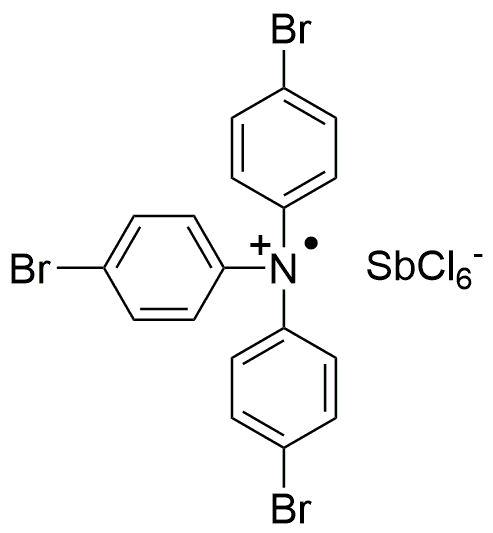Tris(4-bromophenyl)ammoniumyl hexachloroantimonate is widely utilized in research focused on:
- Organic Electronics: This compound serves as a key material in the development of organic semiconductors, enhancing the performance of devices like organic light-emitting diodes (OLEDs) and organic photovoltaics.
- Photonic Applications: Its unique properties make it suitable for use in photonic devices, where it can improve light manipulation and signal processing, crucial for telecommunications.
- Catalysis: This chemical is employed as a catalyst in various organic reactions, offering efficiency and selectivity that can outperform traditional catalysts, thus reducing waste and improving yields.
- Material Science: It is used in the synthesis of advanced materials, particularly in creating composites that require enhanced thermal and electrical conductivity.
- Research in Nanotechnology: The compound plays a role in the fabrication of nanostructures, which are essential for developing next-generation materials with tailored properties for electronics and energy applications.
General Information
Properties
Safety and Regulations
Applications
Tris(4-bromophenyl)ammoniumyl hexachloroantimonate is widely utilized in research focused on:
- Organic Electronics: This compound serves as a key material in the development of organic semiconductors, enhancing the performance of devices like organic light-emitting diodes (OLEDs) and organic photovoltaics.
- Photonic Applications: Its unique properties make it suitable for use in photonic devices, where it can improve light manipulation and signal processing, crucial for telecommunications.
- Catalysis: This chemical is employed as a catalyst in various organic reactions, offering efficiency and selectivity that can outperform traditional catalysts, thus reducing waste and improving yields.
- Material Science: It is used in the synthesis of advanced materials, particularly in creating composites that require enhanced thermal and electrical conductivity.
- Research in Nanotechnology: The compound plays a role in the fabrication of nanostructures, which are essential for developing next-generation materials with tailored properties for electronics and energy applications.
Documents
Safety Data Sheets (SDS)
The SDS provides comprehensive safety information on handling, storage, and disposal of the product.
Product Specification (PS)
The PS provides a comprehensive breakdown of the product’s properties, including chemical composition, physical state, purity, and storage requirements. It also details acceptable quality ranges and the product's intended applications.
Certificates of Analysis (COA)
Search for Certificates of Analysis (COA) by entering the products Lot Number. Lot and Batch Numbers can be found on a product’s label following the words ‘Lot’ or ‘Batch’.
Numéro de catalogue
Numéro de lot/série
Certificates Of Origin (COO)
This COO confirms the country where the product was manufactured, and also details the materials and components used in it and whether it is derived from natural, synthetic, or other specific sources. This certificate may be required for customs, trade, and regulatory compliance.
Numéro de catalogue
Numéro de lot/série
Safety Data Sheets (SDS)
The SDS provides comprehensive safety information on handling, storage, and disposal of the product.
DownloadProduct Specification (PS)
The PS provides a comprehensive breakdown of the product’s properties, including chemical composition, physical state, purity, and storage requirements. It also details acceptable quality ranges and the product's intended applications.
DownloadCertificates of Analysis (COA)
Search for Certificates of Analysis (COA) by entering the products Lot Number. Lot and Batch Numbers can be found on a product’s label following the words ‘Lot’ or ‘Batch’.
Numéro de catalogue
Numéro de lot/série
Certificates Of Origin (COO)
This COO confirms the country where the product was manufactured, and also details the materials and components used in it and whether it is derived from natural, synthetic, or other specific sources. This certificate may be required for customs, trade, and regulatory compliance.


